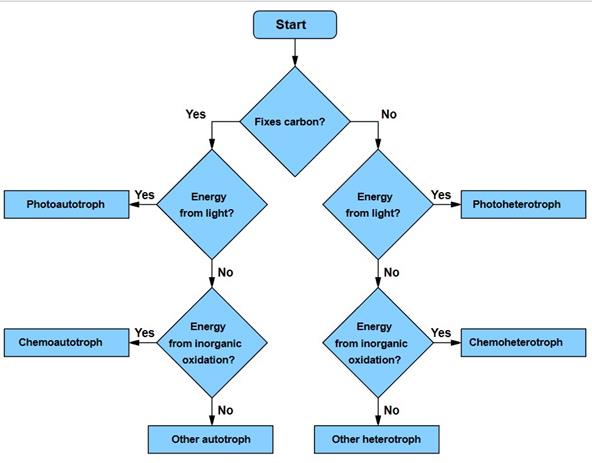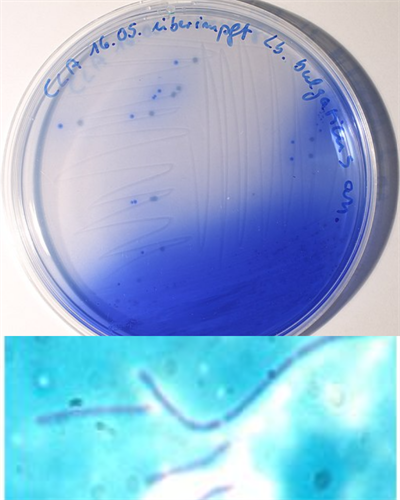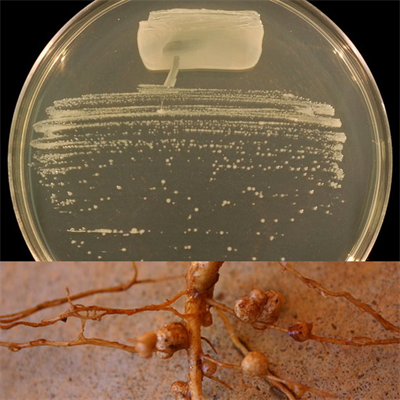
PUMPA - SMART LEARNING
எங்கள் ஆசிரியர்களுடன் 1-ஆன்-1 ஆலோசனை நேரத்தைப் பெறுங்கள். டாப்பர் ஆவதற்கு நாங்கள் பயிற்சி அளிப்போம்
Book Free DemoAll living organisms require energy obtained from different sources such as carbon, nitrogen, iron, phosphorous, and many other molecules. Bacteria, too have various energy requirements.
Based on the modes of nutrition, bacteria's are categorised into,
- Autotrophic
- Heterotrophic

The types of bacteria based on the nutrition
I. Autotrophic bacteria (Autotrophs):
Autotrophic bacteria can synthesise their food from simple inorganic sources such as \(CO_2\) and hydrogen donors viz., \(H_2O\), \(H_2S\) salts.Autotrophic bacteria can be classified into two types based on their source of energy.
Example:
Nitrosomonas sp.
1. Phototrophs:
The organisms which make use of light as an energy source are called phototrophs. These bacteria gain energy from sunlight.
Example:
Cyanobacteria, algae and many photosynthetic bacteria
2. Chemotrophs:
These bacteria gain energy from chemical compounds. They cannot carry out photosynthesis.
Example:
Nitrogen-fixing bacteria and sulphur-oxidising bacteria.
II. Heterotrophic bacteria (Heterotrophs):
Heterotrophic bacteria are widely distributed and most abundant in nature. The heterotrophic bacteria do not produce their food, and they depend on other organisms or dead organic matter.
They are classified as,
1. Parasitic bacteria:
A parasitic bacteria lives in another organism or host, such as plants, animals, and humans. These bacteria attain their nutrition from the tissues of the hosts on which they grow and multiply. They can even cause severe diseases to the living host. It depends on its host for survival. Without a host, a parasite cannot live, grow and multiply.
Example:
Bacillus anthracis is a parasitic bacterium, causes an infectious disease called anthrax.
2. Saprophytic bacteria:
Any organisms that live or feed on other dead, decaying or decomposed organic matter are called saprophytes. These bacteria convert the complicated organic matter into simpler substances and use the simpler substances for various metabolic activities.

Saprophytic bacterial colonies
3. Symbiotic bacteria:
The term 'symbiosis' is derived from the Greek words 'Sym' means 'with' and 'biosis' means 'living', which means living together. In symbiosis or mutualism, two different types of organisms live and work together for their mutual benefit from each other. They share shelter and nutrients. They live inside a living host to obtain nutrition and benefit the host in the digestion process.

Nitrogen-fixing bacteria, Rhizobium - found in roots of leguminous plants
The typical examples are nitrogen-fixing bacteria, Rhizobium. \(N_2\) fixing bacteria live inside the roots of leguminous plants. These bacteria fix free atmospheric nitrogen into nitrogenous compounds used by the plants' roots. In return, the plant offers nutrients and protection to the bacteria.
Reference:
https://upload.wikimedia.org/wikipedia/commons/0/0e/Troph_flowchart.svg
https://upload.wikimedia.org/wikipedia/commons/c/cf/201208_Cyanobacteria.png
https://upload.wikimedia.org/wikipedia/commons/2/24/Nm-eutropha.jpg
https://upload.wikimedia.org/wikipedia/commons/thumb/8/87/Lactobacillus_bulgaricus_colonies_04.jpg/512px-Lactobacillus_bulgaricus_colonies_04.jpg
https://upload.wikimedia.org/wikipedia/commons/6/6b/Microscopic_Image_Lactobacillus_bulgaricus_GLB44.jpg
https://upload.wikimedia.org/wikipedia/commons/thumb/a/a5/Rhizobia_nodules_on_Vigna_unguiculata.jpg/512px-Rhizobia_nodules_on_Vigna_unguiculata.jpg
https://commons.wikimedia.org/wiki/File:Rhizobium_tropici_strain_BR816_on_TY_agar.JPG